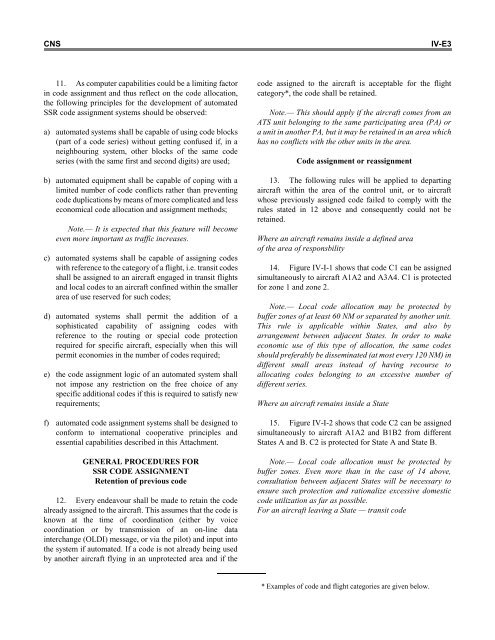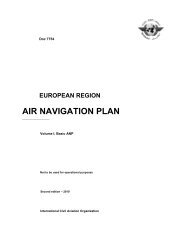7754 Vol 2 Flyleaf - ICAO Public Maps
7754 Vol 2 Flyleaf - ICAO Public Maps
7754 Vol 2 Flyleaf - ICAO Public Maps
Create successful ePaper yourself
Turn your PDF publications into a flip-book with our unique Google optimized e-Paper software.
CNS<br />
IV-E3<br />
11. As computer capabilities could be a limiting factor<br />
in code assignment and thus reflect on the code allocation,<br />
the following principles for the development of automated<br />
SSR code assignment systems should be observed:<br />
a) automated systems shall be capable of using code blocks<br />
(part of a code series) without getting confused if, in a<br />
neighbouring system, other blocks of the same code<br />
series (with the same first and second digits) are used;<br />
b) automated equipment shall be capable of coping with a<br />
limited number of code conflicts rather than preventing<br />
code duplications by means of more complicated and less<br />
economical code allocation and assignment methods;<br />
Note.— It is expected that this feature will become<br />
even more important as traffic increases.<br />
c) automated systems shall be capable of assigning codes<br />
with reference to the category of a flight, i.e. transit codes<br />
shall be assigned to an aircraft engaged in transit flights<br />
and local codes to an aircraft confined within the smaller<br />
area of use reserved for such codes;<br />
d) automated systems shall permit the addition of a<br />
sophisticated capability of assigning codes with<br />
reference to the routing or special code protection<br />
required for specific aircraft, especially when this will<br />
permit economies in the number of codes required;<br />
e) the code assignment logic of an automated system shall<br />
not impose any restriction on the free choice of any<br />
specific additional codes if this is required to satisfy new<br />
requirements;<br />
f) automated code assignment systems shall be designed to<br />
conform to international cooperative principles and<br />
essential capabilities described in this Attachment.<br />
GENERAL PROCEDURES FOR<br />
SSR CODE ASSIGNMENT<br />
Retention of previous code<br />
12. Every endeavour shall be made to retain the code<br />
already assigned to the aircraft. This assumes that the code is<br />
known at the time of coordination (either by voice<br />
coordination or by transmission of an on-line data<br />
interchange (OLDI) message, or via the pilot) and input into<br />
the system if automated. If a code is not already being used<br />
by another aircraft flying in an unprotected area and if the<br />
code assigned to the aircraft is acceptable for the flight<br />
category*, the code shall be retained.<br />
Note.— This should apply if the aircraft comes from an<br />
ATS unit belonging to the same participating area (PA) or<br />
a unit in another PA, but it may be retained in an area which<br />
has no conflicts with the other units in the area.<br />
Code assignment or reassignment<br />
13. The following rules will be applied to departing<br />
aircraft within the area of the control unit, or to aircraft<br />
whose previously assigned code failed to comply with the<br />
rules stated in 12 above and consequently could not be<br />
retained.<br />
Where an aircraft remains inside a defined area<br />
of the area of responsbility<br />
14. Figure IV-I-1 shows that code C1 can be assigned<br />
simultaneously to aircraft A1A2 and A3A4. C1 is protected<br />
for zone 1 and zone 2.<br />
Note.— Local code allocation may be protected by<br />
buffer zones of at least 60 NM or separated by another unit.<br />
This rule is applicable within States, and also by<br />
arrangement between adjacent States. In order to make<br />
economic use of this type of allocation, the same codes<br />
should preferably be disseminated (at most every 120 NM) in<br />
different small areas instead of having recourse to<br />
allocating codes belonging to an excessive number of<br />
different series.<br />
Where an aircraft remains inside a State<br />
15. Figure IV-I-2 shows that code C2 can be assigned<br />
simultaneously to aircraft A1A2 and B1B2 from different<br />
States A and B. C2 is protected for State A and State B.<br />
Note.— Local code allocation must be protected by<br />
buffer zones. Even more than in the case of 14 above,<br />
consultation between adjacent States will be necessary to<br />
ensure such protection and rationalize excessive domestic<br />
code utilization as far as possible.<br />
For an aircraft leaving a State — transit code<br />
* Examples of code and flight categories are given below.














